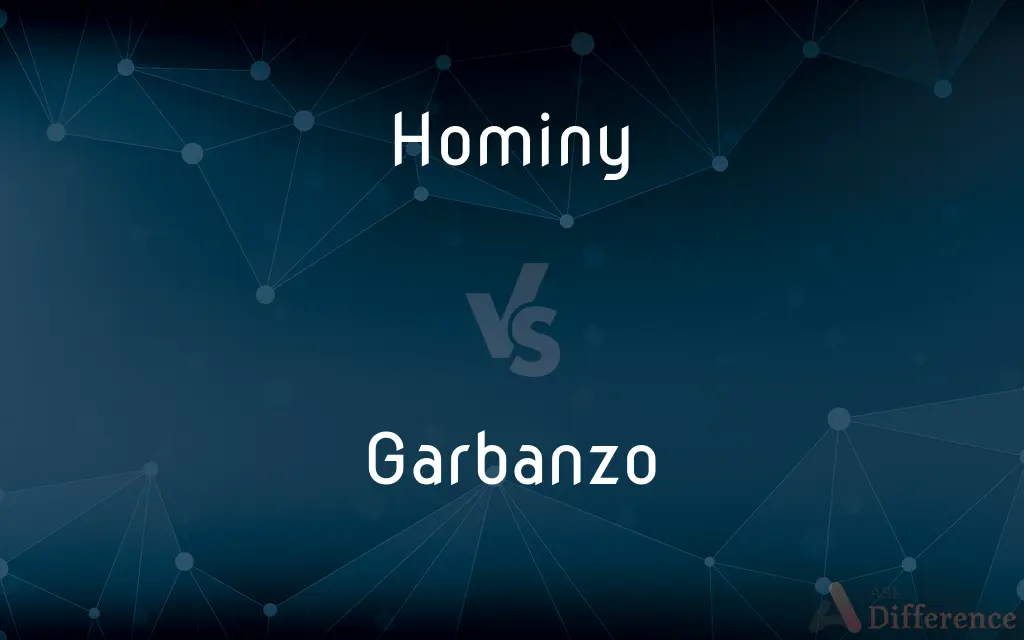Hominy vs. Garbanzo — What's the Difference?
By Urooj Arif & Fiza Rafique — Updated on March 29, 2024
Hominy refers to dried maize kernels treated with an alkali, often used in Southern and Latin American cuisine, while garbanzo beans, or chickpeas, are legumes used globally in various dishes, known for their nutty flavor.

Difference Between Hominy and Garbanzo
Table of Contents
ADVERTISEMENT
Key Differences
Hominy is made through a process called nixtamalization, where maize (corn) kernels are soaked and cooked in an alkali solution, usually lime or lye. This process removes the hull and germ, resulting in a unique flavor and texture that's different from regular corn. Hominy can be ground into masa for making tortillas or used whole in dishes like posole. On the other hand, garbanzo beans, also known as chickpeas, are a type of legume that is versatile and rich in protein, fiber, and several vitamins and minerals. They are commonly used in Middle Eastern and Indian cuisines, featured in dishes such as hummus and chana masala.
While hominy primarily serves as a base or component in specific traditional dishes, offering a chewy texture and a capability to absorb flavors well, garbanzo beans are celebrated for their nutritional value and ability to act as a primary ingredient in a wide range of recipes, from salads to soups to purees. Garbanzo beans have a distinct nutty taste and a grainy texture, making them a popular choice for vegetarian and vegan dishes as a protein source.
One of the key differences between the two is their origin and the way they're processed. Hominy's preparation involves a chemical transformation that enhances its nutritional value by making niacin more available and improving its amino acid profile. Garbanzo beans, in contrast, are consumed in their natural form, either dried or canned, without the need for such processing.
In terms of culinary use, hominy is often associated with specific cultural cuisines and dishes, playing a crucial role in the identity and tradition of those foods. Garbanzo beans enjoy a broader utility across various global cuisines, valued both for their taste and nutritional benefits. They can be easily incorporated into a variety of meal types, serving as a staple ingredient in both traditional and contemporary recipes.
Comparison Chart
Type
Processed maize (corn)
Legume
ADVERTISEMENT
Preparation
Nixtamalization with an alkali solution
Cooked from dried or canned, no processing required
Texture
Chewy
Grainy and firm
Flavor
Mild, able to absorb flavors well
Nutty
Nutritional Value
High in fiber, with available niacin post-processing
High in protein, fiber, vitamins, and minerals
Culinary Uses
Base in traditional dishes like posole
Versatile use in salads, soups, purees, and snacks
Origin
Southern and Latin American cuisine
Global, with prominence in Middle Eastern and Indian cuisines
Compare with Definitions
Hominy
Can be used whole or ground.
Whole hominy adds texture to soups, while ground hominy is ideal for doughs.
Garbanzo
High in protein and fiber.
Garbanzo beans are a great vegetarian protein source in salads.
Hominy
Offers a chewy texture and mild flavor.
Hominy absorbs the flavors of the broth it's cooked in, enhancing the dish.
Garbanzo
Nutty-flavored legumes, also known as chickpeas.
Garbanzo beans are the primary ingredient in hummus.
Hominy
Processed maize kernels treated with an alkali.
Hominy is a key ingredient in traditional Mexican posole.
Garbanzo
Versatile in culinary use.
Roasted garbanzo beans make a nutritious and crunchy snack.
Hominy
Nutritionally enriched through nixtamalization.
Nixtamalization increases the availability of niacin in hominy.
Garbanzo
Common in Middle Eastern and Indian cuisines.
Chana masala, an Indian dish, features garbanzo beans in a spicy sauce.
Hominy
Used in Southern and Latin American cuisines.
Ground hominy is used to make masa for tortillas and tamales.
Garbanzo
Consumed in various forms: dried, canned, or ground.
Ground garbanzo beans are used to make flour for baking.
Hominy
Hominy is a food produced from dried maize (corn) kernels that have been treated with an alkali, in a process called nixtamalization (nextamalli is the Nahuatl word for "hominy"). "Lye hominy" is a type of hominy made with lye.
Garbanzo
See chickpea.
Hominy
Coarsely ground corn (maize) used to make grits
Hominy grits
Garbanzo
An edible pulse, Cicer arietinum, of the family Leguminosae or Fabaceae and subfamilies Faboideae or Papilionoideae, with white or purple-blue flowers and small feathery leaves on both sides of the stem and pods containing two to three peas.
Hominy
Whole or ground kernels of corn from which the hull and germ have been removed, as by boiling in a solution of water and lye.
Garbanzo
A seed of this plant; the chickpea.
Hominy
A food made from hulled corn (maize) kernels soaked in lye water, rinsed, then cooked and eaten; or, the rinsed kernels are dried and coarsely ground into hominy grits.
Garbanzo
The seed of the chickpea plant
Hominy
Maize hulled and broken, and prepared for food by being boiled in water.
Garbanzo
Large white roundish Asiatic legume; usually dried
Hominy
Hulled corn with the bran and germ removed
Common Curiosities
How does the texture of hominy compare to that of regular corn?
Hominy has a chewier texture than regular corn due to the removal of the hull and germ through nixtamalization.
Can hominy be considered a whole grain?
While hominy starts from whole maize kernels, the nixtamalization process alters its natural state, so it's not considered a whole grain in the traditional sense.
Can garbanzo beans be used in desserts?
Yes, garbanzo beans can be used in desserts, especially when ground into flour, offering a high-protein and gluten-free option.
Can people with gluten intolerance consume garbanzo beans?
Yes, garbanzo beans are gluten-free and safe for people with gluten intolerance or celiac disease.
What is the main nutritional benefit of hominy?
Hominy is high in fiber and, through nixtamalization, provides bioavailable niacin and improved amino acid content.
Are garbanzo beans good for weight management?
Yes, garbanzo beans are beneficial for weight management due to their high fiber and protein content, which can promote satiety.
What are the storage requirements for hominy and garbanzo beans?
Dried hominy and garbanzo beans should be stored in airtight containers in a cool, dry place. Canned versions should be refrigerated after opening.
What is a common dish made with hominy in the United States?
In the United States, hominy grits, made from ground hominy, are a common dish, particularly in the South.
Is it necessary to soak garbanzo beans before cooking?
Yes, if using dried garbanzo beans, soaking them overnight before cooking is recommended to reduce cooking time and improve digestibility.
How do hominy and garbanzo beans impact environmental sustainability?
Both crops generally have a lower environmental footprint compared to animal-based proteins, but garbanzo beans, as legumes, also enrich soil fertility through nitrogen fixation, potentially offering added environmental benefits.
Share Your Discovery

Previous Comparison
Sit vs. Situate
Next Comparison
Unfurl vs. HoistAuthor Spotlight
Written by
Urooj ArifUrooj is a skilled content writer at Ask Difference, known for her exceptional ability to simplify complex topics into engaging and informative content. With a passion for research and a flair for clear, concise writing, she consistently delivers articles that resonate with our diverse audience.
Co-written by
Fiza RafiqueFiza Rafique is a skilled content writer at AskDifference.com, where she meticulously refines and enhances written pieces. Drawing from her vast editorial expertise, Fiza ensures clarity, accuracy, and precision in every article. Passionate about language, she continually seeks to elevate the quality of content for readers worldwide.














































